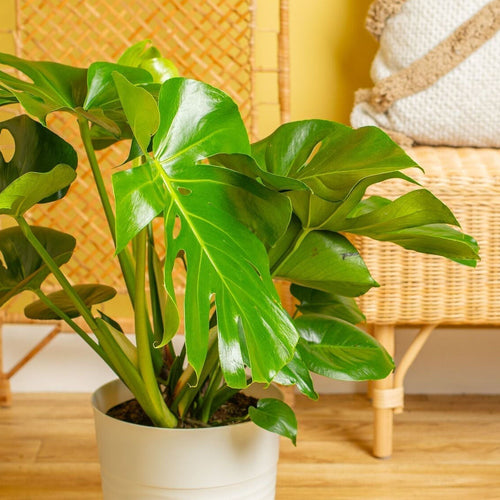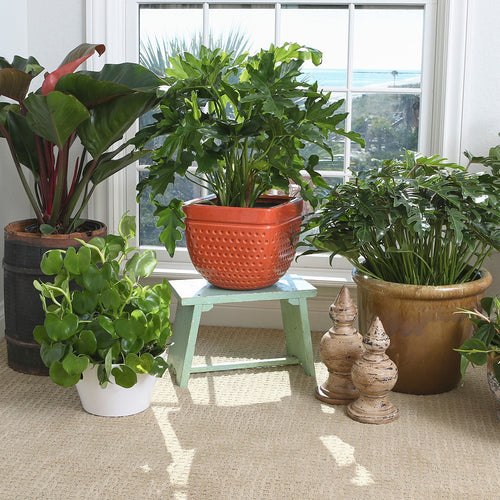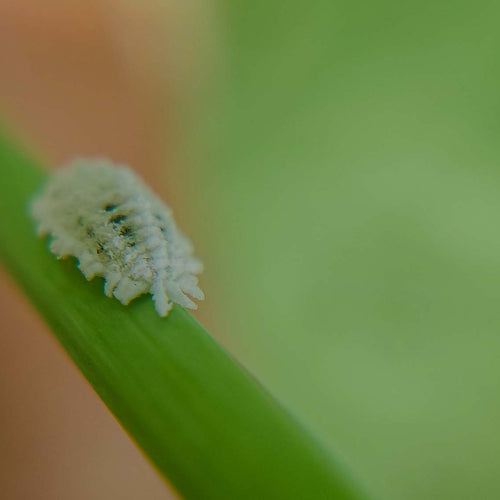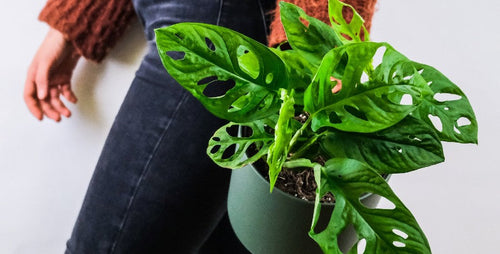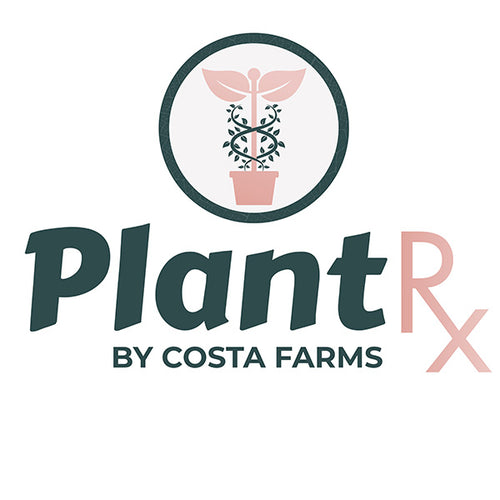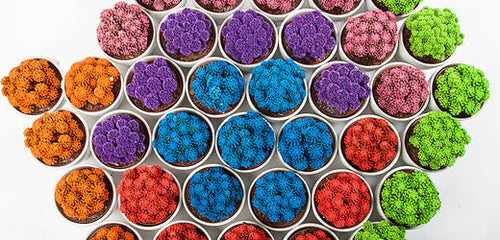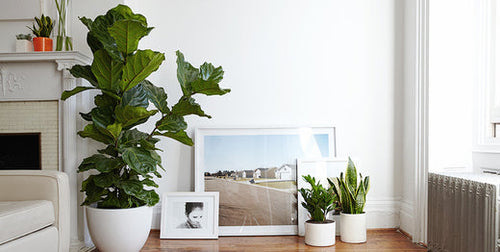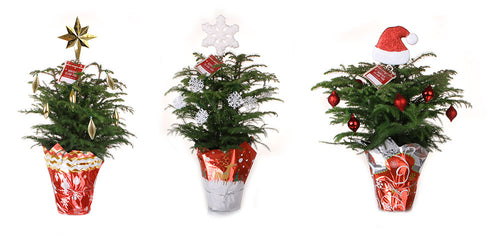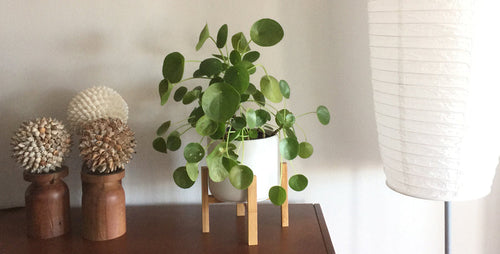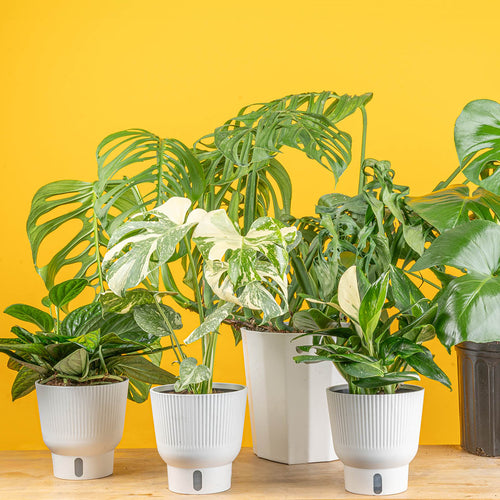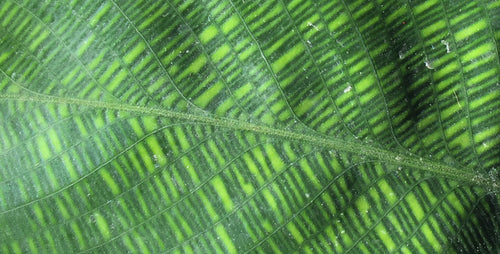
Polka Dot Begonia
It's all about the dots,” says Mike Rimland, Costa Farms Plant Hunter, about Polka Dot begonia.Mike travels the world looking for the new plants to introduce to the American plant market. He knows what will look stunning on the shelf of your home, but he also knows which plants that new plant parents will also be successful with.
In clothing, in indoor décor, spots and dots are a common decorative theme. But it's relatively uncommon. “Not many plants have this feature,” he says. The large wing-shape leaves are accented with silver dots that pop out from the dark-green background. The dots, their metallic quality, the wings: it all added up to a winner. Polka Dot begonia (Begonia maculata) is a native of Brazil. It has a Carnival feel to it!
Costa Farms chose to develop this plant commercially because it was so showy. “In the US, this begonia was commercially rare, but collectors loved it.” In an article in Nursery Management Magazine, Mike says “There are two definitions of ‘rare.’ The collector rare includes plants you find on the side of a hill in the Philippines that no one has seen and commercially rare is when no one is producing any volume of the plant. You tend to find these through internet sources where prices are very expensive,” Mike says.
“Our goal is to take the commercially rare plants that we believe are easier for the home gardener and produce the volume that will bring the prices down, as well as bring them to the local stores where they shop.”

Nanouk Tradescantia
This showy little plant has foliage that is bright green, white, and pink -- a lovely little trio-color effect. The almond-shape leaves are slightly fuzzy and grow very close together on the stem, giving a very lush overall look of the plant.Tradescantias are native to South America, but Nanouk was developed in The Netherlands. The variegated leaves are the main attraction of this plant group. (See other Tradescantia varieties.)
In addition to its lovely pink hue, Nanouk also produces beautiful little pinkish-white flowers. Like Raven® ZZ, Nanouk is also a patented plant. In the patent description, Nanouk is described as unique (and hence patentable) for the following characteristics: “Compact and upright to broadly spreading plant habit, h2 and healthy leaves with light purple, green and gray-green leaves, and is good (for) interiorscape performance.”
It’s all about the pink,” says Mike. “The variegation is so interesting,” he says.

Network Calathea (Calathea musaica)
Mike is always hunting for a species (or a variety within a species) that is good or better than what’s out in the plant world. Why settle for less?It was the visual appeal of Network™ Calathea that first caught Mike's eye, but it was his wife who really took a shine to Network. So Mike took a second look. In the case of Network™ case, it was the leaves. “It has a thicker leaf,” he said. And the veins in the leaf were different. Interesting. And had that visual appeal that added Network to the list.
This plant is also patented, The description for this plant from the patent says “A new and distinct Calathea musaica cultivar,” it is named ‘PP0005’ for the patent purposes, and the reason it has a patent is because it is unique “characterized by a compact, bushy plant habit, and h2ly variegated foliage.” The inventor of this plant is from The Netherlands, and made the selection in a greenhouse in Holland during September 2005. Justin Hancock, Costa Farms Horticulturist, describes the leaves of Network™ this way: “They form a pattern that almost looks like a digital network.”Although Costa Farms calls this plant Calathea musaica, you might also see this plant sold under the botanical name Goeppertia kegeljanii. Network™ differs from Calathea musaica in that it's more compact and bushier, with smaller leaf stems. It also offers more pronounced variegation than the standard Calathea musaica. Costa Farms is the only plant grower in North America that has negotiated rights with the patent holder to propagate it.

Watermelon peperomia (Peperomia argyreia)
Envision the swirly white-and-green skin of a summer watermelon, then crack it open to expose the bright red center. That color scheme (green, white, and red) -- inspired the name of this delicious peperomia. Watermelon peperomia produces beautiful tear-drop leaves. The swirly white stripes are slightly sliver and the red leaf stems (called petioles) add pizzazz. The leaves of this stunning plant are fleshy and round. Watermelon is native to South America.The Trending Tropicals® Collection strives to create diversity and visual impact. Watermelon’s colorful demeanor makes it a prime selection. “It’s all about the stripes,” says Mike about this beautiful plant. Watermelon is also an easy-care indoor plant. The fleshy leaves help retain plant moisture so you don’t have to worry about watering it all the time. In fact, says Justin. Watermelon “is rather sensitive to overwatering, so if you're in doubt about whether to give it a drink, it's usually best to wait.” Watermelon peperomia’s relatively thick leaves allows the plant to hold up well if it gets a little too dry.

Shingle Plant (Rhaphidorphora hayi)
Shingle plant produces aerial roots along its stem that grab onto a vertical surface. This climbing plant is so striking because of how it grows. Shingle plant is called this because the leaves grow in an overlapping way -- but they also need a flat surface, such as a wooden shingle, to grow on."It’s all about the shingle,” laughs Mike. Once the plant grabs onto the flat surface, the large, heart-shape leaves hug the shingle growing upward, overlapping the board like fish scales. If you are looking for a unique and interactive plant, try Shingle Plant. Justin says that nearly anyone can raise this plant indoors. “Shingle plant grows happily with natural or artificial light. If you don't have a bright window to grow it near, it can thrive under fluorescent or LED lights.”

Raindrop Peperomia (Peperomia polybotrya)
Some of the Trending Tropicals® plant species have been around awhile,” says plant hunter Mike Rimland. “Some are popular in Europe.” And most of these plants, Raindrop included, are on the “coveted list” for plant collectors in this country. With the roll out of the Trending Tropicals collection, these unusual plants are now also available for the new plant buyer."It’s all about the green thick leaf,” Mike explains. Here’s why: The thicker the leaf, the more drought and low-light tolerant it is. For the plant owner, Raindrop offers a cool look, but it is also easy to care for. Raindrop peperomia can thrive beautifully under artificial light, such as fluorescent or LED bulbs.

Sterling Silver Scindapsus
“Sterling Silver is a winner. This plant was a blockbuster right out of the gates online,” says Mike Rimland. Why? Well, Sterling Silver has a lot going for it. It’s beautiful, for one. The metallic accents (hence its name Sterling Silver) are gorgeous. It’s also flexible as an element of indoor decor. You can train its vining stems up a trellis, let the plant grow horizontally across a tabletop, or hang it up and watch it trail down.) But best of all, it’s easy. Sterling Silver scindapsus (also called Scindapsus treubii 'Moonlight') is a close relative of pothos (Epipremnum) and philodendron, but it's much less common. It’s rareness is also one of it’s selling points.“It's all about the silver,” says Mike Rimland. Metallic accents are rare in the plant world. “This one really took off on Instagram,” he says. Take a look and you’ll see that the combination of dark green foliage kissed with a silvery sheen is irresistible. Justin Hancock, Costa Farms Plant Guru, adds “It has been a relatively uncommon and hard-to-find houseplant despite its good looks and easy-growing nature.” All that is changing now that it’s a member of the Trending Tropicals® Collection.

Maze Plant (Hydnophytum papuanum)
Maze Plant is an exotic looking plant that is indigenous to Africa. Its unique footed base -- called a cadex -- is as beautiful as it is utilitarian. The wide base of the plant is filled with a maze of tunnels that help this plant store water.Also of interest is this: Maze plant has a structure that allows it to have a mutualistic relationship with the ants that live in its indigenous areas. Mutualism is an ecological beneficial interaction between species. In this case, the relationship is between the base of the plant and ants. In their wild habitat, ants move into the maze cavities using it as shelter and food. The ants return the favor by providing nutrients, pollination, seed dispersal, and protection. Nature friends! Rest assured that your Maze plant will not attract ants in your home.
The cadex of this plant holds so much water, so Maze Plant is very drought tolerant. “It’s all about the low maintenance,” says Mike Rimland. It’s one tough plant. In fact, Mike says “It’s difficult to kill it.” This is good news indeed for fans who love unusual plants but may sometimes forget to water.

Birkin
Philodendrons have been a popular houseplant for years. There are hundreds of species of philodendrons, each with their own unique beauty. It’s a very diverse group. And not all philodendrons can grow successfully indoors. You may know this plant as the hanging plant over your best friend’s kitchen sink or the big floor plant at your favorite home decor store. This plant group comes in many forms. Their leaf shape can be large or smallish, heart-shape, oval, lobed, or deeply cut. But one thing that the majority of philodendrons have in common, is that their leaves are green.Enter Birkin. This extraordinary philodendron has large almond-shape leaves that are striped with creamy white veins. Native to the tropical areas of North and South America, philodendrons are now grown indoors all over the world.
“It’s all about the stripes,” says Mike Rimland. “We already have lots of all-green philodendrons,” says Mike. The creamy white lines in Birkin are very defined, and that’s a cool thing to see. Birkin has caught the eye of Instagramers around the world. Adjectives of praise include words like “rare,” “gorgeous,” “must-have.” Home decor fans love this plant because it can stand alone as a focal point or mix in well with other green houseplants, raising their visual profile. Here’s how to care for your Birkin.
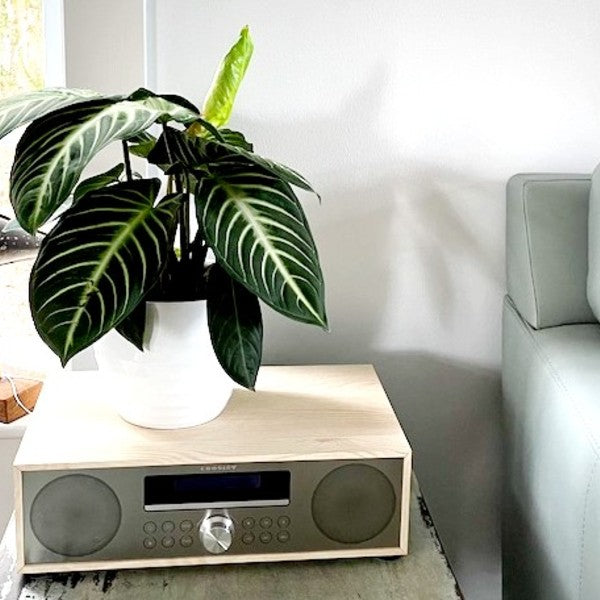
Xanthosoma
You may not have heard of Xanthosomo (it’s pronounced ZAN-THO-SO-MO), but once you see it, you may never forget it. This tropical beauty is originally from Colombia and has it all: good looks, striking variegation, big leaves, and easy care."Xanthosoma is not a new plant” says Mike Rimland. But it has garnered some attention. Why? It has beautiful variegation. “This plant is getting a new lease on life -- because of the Trending Tropicals® Collection inclusion.
Xanthosoma thrives in medium to bright, indirect light. And for those of us that may have less natural light in some rooms, this plant does well under artificial lights, such as fluorescent or LED bulbs.

Green Galaxy
Monsteras are originally found growing in hot, humid tropical regions of North and South America. Most people think of Monsteras, they are thinking of a plant with large, smooth, lobed leaves. They are thinking of Monstera deliciosa. Green Galaxy offers a different take on Monstera (and may become a popularity contender). This exotic houseplant features fabulously textured foliage with a ripped, almost corrugated appearance. There’s a subtle iridescence in the leaves. When shopping you may also see Green Galaxy sold as Monstera sp. Peru.Green Galaxy has similar growing needs to other monstera varieties. According to Costa Farms Plant Guru, Justin Hancock, “Like other climbing aroids, you can enjoy Green Galaxy a multitude of ways.” One trendy way to grow it is climbing upright on a totem. It’s also an elegant choice trailing from a hanging basket or horizontally across a tabletop, mantle, or desk,” he says. Although it’s a slow grower, this plant can easily climb more than 6 feet indoors.
Mike Rimland says, “This is a super great plant. It’s all about the contrast.” When you look closely at the leaves you see that the veins are slightly yellow. “This is a collector’s plant,” says Mike. “But it is commercially rare,” he says. Watch this space for more news about this interesting new Monstera.







